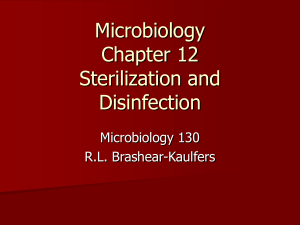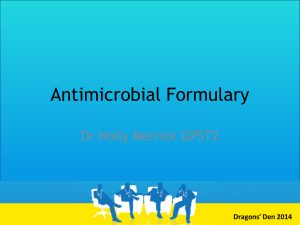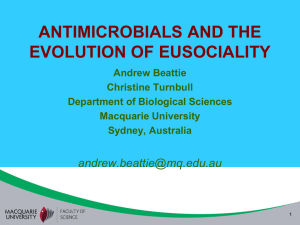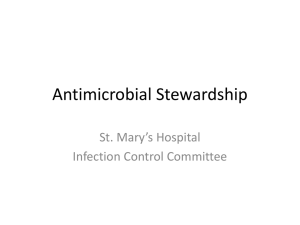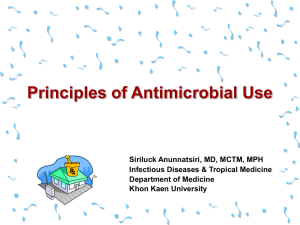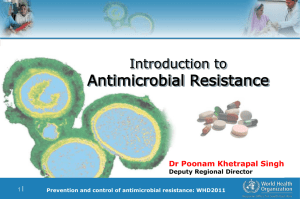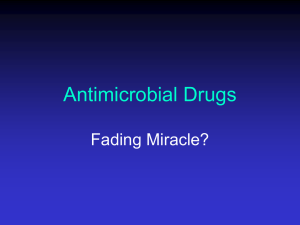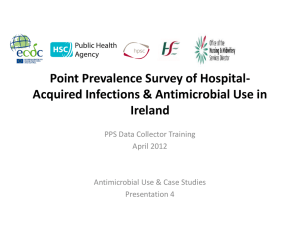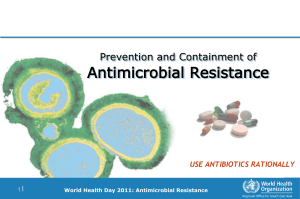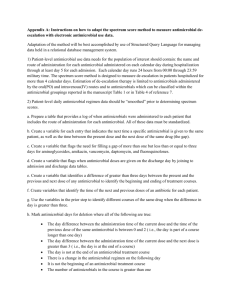Basic Principle of Chemotherapy of Infection
advertisement
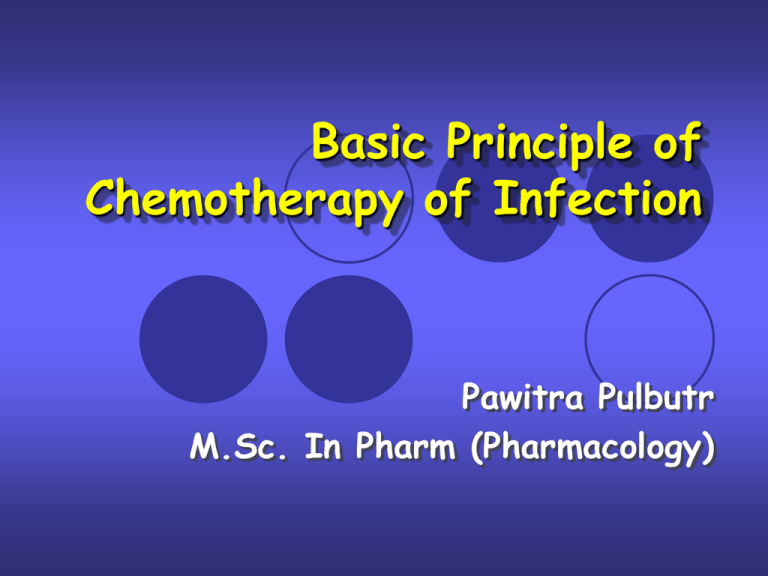
Basic Principle of Chemotherapy of Infection Pawitra Pulbutr M.Sc. In Pharm (Pharmacology) วัตถุประสงค์ อธิบายปัจจัยในการพิจารณาเลือกใช้ยา Antimicrobial เข้าใจการใช้ยาแบบ Empirical therapy และ Antimicrobial therapy of infections with known origin เข้าใจการหลักการในการวัด susceptibility test อธิบายที่มาและความหมายของ MIC, MBC อธิบายความหมายและความแตกต่างของ bactericidal และ bacteriostatic ได้ อธิบายความหมายและความแตกต่างของ Concentration dependent killing และ Time dependent killing อธิบายความหมายและความสาคัญของ PAE อธิบายปัจจัยทางเภสัชจลนศาสตร์ท่มี ีผลต่อการเลือกใช้ยา Antimicrobial อธิบายกลไกการเกิด synergism และ antagonism อธิบายความหมายและกลไกการดื้อยาของเชื้อทัง้ environmentally mediated resistance และ microorganism mediated resistance ของยาต้าน แบคทีเรียแต่ละกลุ่มได้ What is Chemotherapy ? • Use of chemicals (agents) to eradication cells • Chemotherapy of infection • use of chemical antimicrobial or antibiotics to eradicate infective pathogens • Cancer chemotherapy • use of chemical agents to eradicate cancer cells Antibiotics ยาปฏิชีวนะ • Microorganism origin • Antimicrobial activity Antimicrobial ยาต้านจุลชีพ • Chemicals or Antibiotics • Antimicrobial activity Factor affecting chemotherapy of infection Host factor Organism factor Pharmacological factor • type/ strain • physiology • pharmacodynamics • susceptibility • allergy • pharmacokinetics • resistance • age • toxicity/ ADRs • pregnancy • drug interaction • infective site • immune status • previous antimicrobial • concomitant drugs Chemotherapy of infection • Empirical antimicrobial therapy • Unknown type of infective pathogens • Unknown susceptibility • Antimicrobial therapy of infection with known origin • Known type of infective pathogens/ susceptibility • Choose the right drug for right pathogen >>> Ideal Antimicrobial agents with known etiology • known infective pathogens & susceptibility • Use the right drug … Narrow spectrum Susceptibility testing • In vitro test • Minimum inhibitory concentration (MIC) • ความเข้มข้นของยาตา่ ที่สดุ ที่สามารถยับยัง้ การเจริญของเชื้อ • Minimum bactericidal concentration (MBC) • ความเข้มข้นของยาตา่ ที่สดุ ที่สามารถฆ่าเชื้อได้ Antimicrobial pharmacodynamics Bacteriostatic VS Bactericidal • Bacteriostatic • inhibit bacteria growth • MBC >>>>> MIC Protein synthesis inhibitor • Bactericidal • kill bacteria • MBC > MIC Depends on … • mechanism of action • type/ strain of infective pathogen Cell wall synthesis inhibitor Concentration dependent killing VS Time dependent killing Concentration dependent killing • ความสามารถในการฆ่าเชื้อขึ้นกับความเข้มข้นของยา • higher peak conc….higher killing action • Aminoglycosides • Quinolones Time dependent killing • ความสามารถในการฆ่าเชื้อขึ้นกับระยะเวลาที่เชื้อสัมผัสกับยา ณ ความเข้มข้นของยาที่สูงกว่า MIC • killing depends on… Time above MIC • Saturation of action on target • Beta lactam antibiotics • Vancomycin Post antibiotic effect (PAE) • ความสามารถในการยับยัง้ การเจริญของเชื้อหลังจากไม่ได้สมั ผัสกับยาแล้ว (ชัว่ โมง) • PAE = T – C • T = Time for bacteria to increase 10 times after drug remove • C = Time for bacteria to increase 10 times without drug How PAE happen ?? • May be …persistent binding of drug on binding site … time for new enzyme synthesis Combination of antimicrobial therapy **Rationale for combination** • Broader spectrum for empirical therapy in serious illness • Polymicrobial infection • Decrease drug resistance • Decrease dose related toxicity • Synergism Environmentally mediated VS Microorganism mediated resistance • Environmentally… Due to physical/ chemical of environment • Microorganism …. Due to intrinsic factor in microorganism Common pathway for antimicrobial resistance • Enzymatic degradation • Decreased uptake or accumulation • Altered antimicrobial target Beta-lactam resistance • Beta-lactamase enzyme production • Staphylococci, Enterococci, Enterobacteriaceae, P. aeruginosa, H. influenzae, N. gonorrhea • different spectrum of activity *** Ambler class … • development of beta-lactamase resistant drug • PBPs affinity alteration • Methicillin resistant S. aureus (MRSA) • Decreased uptake • decrease no. of porin … imipenem resistant in P. aeruginosa Bacterial resistance Survival of the fittest Inappropriate use of anti-infective agents • Emergence of new resistant gene • Spread of resistant gene to new bacteria • Mutation of gene into more resistant gene • Spread of rarely found intrinsic resistant bacteria Chemotherapy of infection • Antibacterial drugs • Cell wall synthesis inhibitors • Protein synthesis inhibitors • Folate synthesis / usage inhibitors • DNA gyrase inhibitors • Cell membrane disturbance >>> lipopeptides • Antiviral drugs • Antifungal drugs • Antimycobacterial drugs • Antiparasitic drugs • Antimalarial drugs • Antiamebic drugs • Anthelmintics

